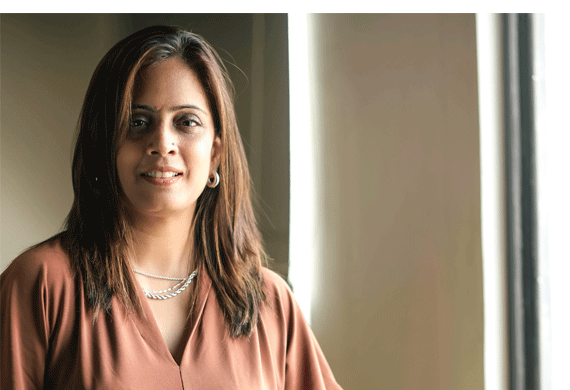Leaders

Pooja Sondhi: An Industry Leader With Considerable Expertise In Designing And Implementing Comprehensive Solutions
Pooja Sondhi
Director & Coo, Livfin India
One of the most attractive areas of IT is the banking and financial services business. Current estimates place the BFSI market at $35.3 billion. By contrast, forecasts put its value at $66.02 billion by 2026. With the use of banking software, consumers may communicate with their local bank offices from any location. With multi-channel banking software, clients may do business with a bank through any of the many available channels, including mobile devices, the web, and physical branches. Given this, Pooja Sondhi, the Chief Operating Officer of LIVFIN, is one of the industry leaders in the country when it comes to the development and deployment of software for the banking sector.
Pooja has a strong background and demonstrated leadership in diverse functional areas of the Financial Sector, and she is a performance- driven Operations & Business Process specialist with 19+ years of experience in the industry. Pooja has worked extensively on financial inclusions via Co - Lending with Banks and NBFCs, establishing a variety of procedures and system connections to handle the transactions.
Engaging in an exclusive interaction with Women Entrepreneur magazine, Pooja spoke about her roles and responsibilities as the COO of LIVFIN, and her leadership journey so far.
What are the various responsibilities that you shoulder in your role as the COO of LIVFIN? Tell us about the major focus areas in your current role.
In 2017, I started my journey with LIVFIN as a member of the Management Team, co-founder, and chief operating officer. My position as a key member of the senior management team is to offer visionary leadership to manage varied business operations and construct a state-of-the-art technical foundation to support the company's growth. To reach financial goals, I was tasked with establishing an overall strategy for operations and converting that plan into measurable functional objectives and key performance indicators. In addition, I spearheaded the company's technological initiatives, which included the development of a marketplace for the dissemination of leads and the consolidation of funding via the platform by bringing all the partners onto a single forum, all to expand access to financial services for underserved populations through Colending with other FIs.
In my current position, I am responsible for developing and enforcing organizational policies and procedures, establishing broad performance and growth targets, and taking part in company development efforts (investments, acquisitions, corporate alliances, etc.). I also led the technological front, designing and developing, and overseeing the creation of the whole technology platform for all areas of the loan process, including application, automated optimizing, 3rd party financial data-source integration, loan lifecycle management, data-driven learning algorithms, and others. The present function necessitates the decision-making skills of both the CTO and the CXO. Furthermore, it is important to construct robust systems that operate on an open architecture to easily interface with other business partners and expand commercial potential.
What are some important features of your expertise as a business leader?
I am an accomplished professional with over 19 years of experience in the financial services industry, specializing in operations and business process management and being motivated by results. I have extensive experience and success as a leader in several different financial industry roles, including those related to operations, operational risk, banking domain consulting, project management and delivery, process development and implementation, people management, vendor management, business continuity planning, and business alliances management.
In addition, I have worked extensively on financial inclusions through Co - Lending with Banks and NBFCs, developing a variety of procedures and system connections to complete transactions. Moreover, I have collaborated with a wide variety of resources in several different countries throughout the world. With my extensive experience in the banking industry's software design and implementation processes, I have provided several solutions to address the whole spectrum of loan life cycle management needs, from origination to repayment. As an alternative, I have focused on developing the Fintech idea to digitalize the processes and empower FIs to make informed choices by serving up data from all available different sources.
In my current role, I am primarily responsible for designing and supervising the development of the entire technology platform used in the lending process, including but not limited to the loan application, automated decisioning, integration of third-party financial data sources, loan life cycle management, and data-driven learning algorithms.
Throw some light on the most critical business challenges you face as a COO. How do you overcome these roadblocks?
As COO, I've had to overcome several significant challenges, including a lack of executive buy-in and support, unclear corporate objectives, and insufficient testing infrastructures. The correct instrument for the task wasn't always clear, and neither was the best way to fix hidden processes that may cause failure. Insufficient process visibility and traceability, as well as rigid third-party contracts and incentives, are further difficulties.
"It is important to construct robust systems that operate on an open architecture to easily interface with other business partners and expand the commercial potential"
In your opinion what are some of the most significant milestones that you have achieved throughout your professional journey? What has been the driving force behind your success as a professional?
My first full-time work and delivering my first official presentation were the first major steps in my professional development. Apart from that, I've reached many other significant milestones, like becoming a project manager, voicing an unpopular view, rising through the ranks, and being in a position to create my processes rather than just follow those of others. If I had to describe what drove me forward in my career, I would say that Instinctive vs. Intellectual understanding, practicality, plus selflessness and resourcefulness were all crucial factors. Not to mention, the kind people and peaceful environment.
What is your take on the gradual rise of women leaders in top leadership roles across industries? What factors can help improve women’s representation in top leadership roles?
The general consensus across cultures is that women are the more community gender (warm, supportive, and kind), whereas males are the more agentic gender (assertive, domineering, and authoritative). Views about leaders are more comparable to beliefs about men than women because of the emphasis placed on leaders' agentic abilities. This is when the gender gap in leadership roles begins to show itself in society. Women are breaking through glass ceilings and climbing to the highest levels of leadership in many countries. Their presence disproves the idea that women face an insurmountable barrier to advancement into top jobs because of the traditional gender role stereotypes that persist to this day. As a result of these variations, a labyrinth is a more apt metaphor for women's routes to leadership than a straight line.
In contrast to a glass ceiling, the walls of a labyrinth don't disappear when some women reach the top of the corporate ladder. This creates obstacles for the women who come after them. The roads men travel on may have some bumps in them, but compared to the labyrinth that women must navigate, men's routes seem like ease. Some women are lost because they can't see beyond the next dead end, while others succeed despite frequent failures and missteps because they refuse to give up. This metaphor of a maze is both hopeful and practical since it recognizes the possibility of women's achievement while also reflecting the fact that it is far from certain. Although, women's achievements are a reflection of both the obstacles they overcame and their abilities and drive. Although women may still encounter greater obstacles than males when seeking leadership positions, things are beginning to improve. I have already seen a partial movement toward an androgynous leader archetype as one example of a current societal trend. The ability to advocate for oneself, the availability of support networks, a positive work environment, and a strong sense of self-worth are all variables that have been shown to increase the number of women in leadership roles.
Drawing from your experience as a business leader, what would your advice be to young women and girls who also aspire to become business leaders and entrepreneurs in the future?
There is no such thing as a glass ceiling since all of us build our barriers and ladders to success. My only rule of thumb has been to make a list of everything that needs to be done and then rank each item in order of importance. Until a solution is found, the issue remains unsolved; if none can be found, the circumstance is not a problem, but rather a notion that can be changed, at which point the problem disappears. We all have our own set of resources from which we may draw and our own set of limitations from which we must ask for assistance.


